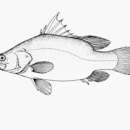Diagnostic Description
provided by Fishbase
Diagnosis: mouth large and protrusible (Ref. 28714, 81285, 81652), lower jaw (slightly) prominent (Ref. 81285, 81652). Numerous villiform teeth present in jaws, on palate (Ref. 81285, 81652) and vomer (Ref. 81652). Preorbital/lachrymal (Ref. 4967, 81652) and preopercle (Ref. 4967, 81285, 81652) denticulate. Strong, prominent opercular spine present (Ref. 4967, 81285, 81652) on free edge of opercle, and a smaller one dorsal to it (Ref. 81652). Dorsal fin divided by a deep notch into anterior spiny and posterior soft-rayed sections; anal fin with 3 spines; pelvics with a spine and situated close to the pectorals (Ref. 28714). Caudal fin rounded (Ref. 4967, 81285, 81652). Scales ctenoid, 54-74 along lateral line, followed by 6-8 pored scales on caudal-fin base; ceratobranchial (lower limb) of first gill arch with 12-14 gill rakers (Ref. 81285). Coloration: body uniformly silvery (Ref. 81285) or dark greyish-blue dorsally, greyish-silver on flank and ventrally (Ref. 34290, 81652). Fins greyish; interior of eye conspicuously yellowish (Ref. 81285). Juveniles brownish with lighter marbling (Ref. 81285) on head and flanks (Ref. 81652).
Diseases and Parasites
provided by Fishbase
Dolops Infestation. Parasitic infestations (protozoa, worms, etc.)
Diseases and Parasites
provided by Fishbase
Ergasilus Disease 6. Parasitic infestations (protozoa, worms, etc.)
Diseases and Parasites
provided by Fishbase
Diplectanum Infestation. Parasitic infestations (protozoa, worms, etc.)
Diseases and Parasites
provided by Fishbase
Gonad Nematodosis Disease. Parasitic infestations (protozoa, worms, etc.)
Diseases and Parasites
provided by Fishbase
Sporozoa Infection (Hennegya sp.). Parasitic infestations (protozoa, worms, etc.)
Migration
provided by Fishbase
Potamodromous. Migrating within streams, migratory in rivers, e.g. Saliminus, Moxostoma, Labeo. Migrations should be cyclical and predictable and cover more than 100 km.
Morphology
provided by Fishbase
Dorsal spines (total): 7 - 8; Dorsal soft rays (total): 8 - 14; Analspines: 3; Analsoft rays: 7 - 9
Trophic Strategy
provided by Fishbase
Prefers sandy bottoms but also found in rocky to muddy bottoms. Zones with vegetation in calm waters provide shelter to larvae and young (Ref. 1456). Sexual dimorphism: females larger than males (Ref. 5160). Diet directly related with its length (Ref. 4726): pelagic larvae are zooplanktivores (Ref. 1456), juveniles feed on planktonic crustaceans and insect larvae found among vegetation (Ref. 11250), adults feed mainly on smaller fish species (Alestes, Micralestes, Tilapia oreochromis, Haplochromis and shrimps (Ref. 11249). Variability of prey species is directly related to the flooding season.
- Recorder
- Crispina B. Binohlan
Biology
provided by Fishbase
Inhabits channels, lakes and irrigation canals (Ref. 28714, 81652). Adults inhabit deep water, while juveniles are found in shallow water (Ref. 81652). Feeds on fish especially clupeids and Alestes (Ref. 13851). Smaller fish also feed on larger crustaceans and insects; juveniles are planktivorous (Ref. 28714). Threatened due to over harvesting (Ref. 58490). No length type given but assumed to be in TL. Maximum reported size of 180.0 cm corresponding to a weight of 164 kg in Lake Albert (Ref. 81285).
Importance
provided by Fishbase
fisheries: highly commercial; aquaculture: commercial; gamefish: yes

